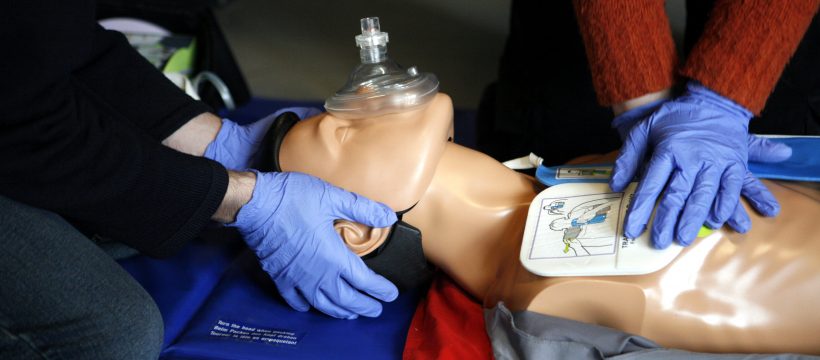
CPRNM® is a comprehensive directory designed to connect individuals and employers with top-tier training
providers including the AHA®, Red Cross®, and other training providers.*
AHA Instructor Network
If you are interested in becoming an AHA instructor but you don’t have the fundamental knowledge about the course, this article contains some helpful basic information.
But first, do you need CPR certification?
(View on Youtube: https://youtu.be/q9vBUCoxteU)
There are several types of AHA instructors with each having a different training. You can decide to either teach the bystander CPR or the basic life support done by healthcare providers.
Whichever area you have interest in, it is mandatory to first complete the core AHA instructor course regardless of the experience you have or previous training. In some cases, you may be allowed to use your previous Red Cross Qualifications for the AHA instructor network but further investigations may be needed. Below are some of the crucial guidelines that you must know.
How to be an AHA Instructor
It is easy to become an AHA instructor. You need to consult with your local AHA center first in order to know if the training center (TC) wants new instructors. The AHA course teaches the methods that are required in order to instruct others effectively in resuscitation courses. The AHA instructors should be at least 16 years and above if they want to join BLS instructor or heart saver instructor courses. The instructors who want to join PALS or ACLS should have a minimum age of 18 years and a certified or licensed in a healthcare occupation where the skills are within the set scope of practice.
Before starting the instructor training program, you should have the provider course card for the course that you intend to take and it must be in alignment with AHA center that you have chosen. The AHA instructor training has mainly two stages:
- The candidate undertakes self-directed instructor essentials online in the chosen area.
- The candidate undertakes hands-on session that is conducted by the training institute faculty. Once the candidate has successfully completed the two steps, the instructor card is given.
Steps followed to become AHA instructor
Step 1: acquire the basic level certification
The instructor level CPR trainees are required to process the basic life support certificate or the basic CPR. The courses are offered in various organizations and institutions and are designed for both healthcare providers and the general public including people who don’t have any healthcare background. No past certification is required hence anyone can apply. The aspiring CPR instructors greatly benefit from attending one of the previous courses because they offer certificates to the graduates upon completion.
Most of the instructions in these programs cover infant and adult CPR methods, first aid basics, calling for help and use of Automated External Defibrillator (AED). The participants must pass the exams before proceeding to the next level. Contacting AHA is very important as it helps one to know if the institution needs new instructors. Contacting AHA while completing the CPR program helps individuals to know whether to pursue the instructor training in AHA or not.
Step 2: Do the Red Cross Pre Instructor Test
Red Cross requires all the aspiring instructors to pass a pre-course exam which can be accessed online before the instructor training. The exam is prerequisite to attending the instructor training that is offered by Red Cross. The students those who intend to attend the program via AHA do not have to undertake this exam.
Step 3: Complete the first course
The training programs offered to instructors by AHA and Red Cross has two courses. The first course is titled Core Instructor Course and is offered by AHA. It teaches preparation and planning, management, instruction methods, cultural sensitivity and assessment through a 20 interactive training module series. The course is done and completed online, by use of a CD or in a classroom. A self-directive format is used when the trainee decides to use the CD. The students are given a certificate after successfully completing the course.
The other course is offered by Red Cross Instructor Training and is titled Fundamental of Instructor Training (FIT). In the course, the participants are introduced and taken through the history, organizational structure and activities.
Step 4: Complete Instructor Course
AHA does not offer solely CPR training but instead offers Heart saver, Basic Life Support, Pediatric Life Support and Advanced Cardiac Life Support courses. All the courses are meant to prepare the graduates to work well as instructors. The classes can be done in a hybrid format, online or in a classroom.
Most of the Red Cross instructor courses target a specific audience and prepare the instructors to perform their work with particular audiences once they complete the coursework. Examples of the audience are lifeguards, emergency response professionals, babysitters and childcare providers. The classes are offered in hybrid formats, online or in classrooms.
Step 5: Practice by Teaching a Class
It is a required by AHA that all new instructors must be monitored while teaching the first course. AHA creates access for the instructors to the online networks. The networks make it possible for the instructors to manage course records, print their certificates, communicate with their fellow instructors and access the training materials. The instructors can also be certified by Red Cross.
Step 6: Re-Certify
The ARC certifications for the instructors are valid for 24 months. The certificates can be renewed provided that the instructor has taught one or more courses in the certification period. AHA instructors must teach two or more courses during the period of certification. The re-certify exam must be passed well.
AHA Instructor Community: Your Instructor forum peers
After becoming a certified AHA instructor, you will enjoy the privilege of getting immediate access to the AHA instructor community and connect with other AHA instructors, gain information and expertise, ask questions and exchange knowledge and so on. Joining the AHA Instructor community brings an exploring opportunity for not only sharing the ideas but also discussing the latest training trends. It’s important to give AHA a feedback as this can leads to a partnership that provides more training services and saves more lives.
Becoming an instructor also enables one to access the course updates, training tools and resources, emergency cardiovascular care techniques and sciences. It becomes easy for one to post the times and dates of the classes and therefore reaches many students through the AHA website.
What you can do in AHA instructor community:
- Post and comments on related blogs
- Start or participate in discussion forums
- View the AHA national events and list the local events
- Share stories, chat with colleagues, ask and answer the raised questions.
- Earn badges depending on your level of activity in the community
- Access the important tools and resources so as to promote your ECC and CPR training.
- Connect with other people and friends
- Join various groups depending on your instructor discipline
These are just some of the activities carried out. Also, AHA continues to make adjustments to the site to accommodate more needs for the lifesaving training program.
What materials do you need to study while taking the AHA instructor course?
AHA course is designed to meet the international training board of standards, performance, and instruction (IBSTPI). This means that you will go through the five competencies that have been identified in the field that you want to study. These include the training program preparations and planning methods, assessment and evaluation methods as well as the instructional methods.
You will also have to study two specific AHA sections that are remediation and cultural sensitivity.
In Which ways can you take the AHA instructor course?
The course can be done in any of these three methods: by classroom training, through a self-study by using a CD course or by completing the training course online.
The mode of study is however decided by the AHA center. There are some that will require the trainees to complete the course by attending classrooms only. It is therefore advisable to check out the particular requirements in the center that you wish to work in. after passing the course, a certificate of completion will be awarded to you and start earning continuing education credits especially if you take the course online.
What do you do next in order to an AHA instructor?
It depends on the instructor type that you intend to become. For instance, if you wish to be a BLS instructor, you will be required to have passed the BLS AHA exams well. If you possess a BLS valid certificate you have completed the core instructor course and also passed, you can start the BLS instructor course in order to become a BLS AHA instructor. You will be affiliated with the AHA training center where you took the course and then have your teaching skills assessed.
If you wish to be a trained medical individual in the advanced life-saving techniques, you will have to take an ACLS instructor course or the Pediatric Life support course if that is your area of interest. If you express interest in any of those advanced courses, you must have AHA BLS instructor card and also be approved by the local training center. Before passing these courses, you will undergo a close monitoring to have your skills of putting the theory into practice assessed.
If your wish is to be a CPR certification instructor, you will be required to train students AHA heart saver course and you will also need to have done and completed the course and hold a CPR certificate.
The renewal process
Train multiple AHA courses preferably in the last couple of years- this can include the renewal/ new classroom courses, testing sessions and skills practice for the e-learning courses.
If you are about to refresh the instructor certificate, you will undergo a close monitoring when teaching a class. The supervision is done by a faculty member in the training center before the renewal class. The new forms used for the monitoring must be signed by the candidate (you), the instructor and one of TCF members. See:
- Print, fill then turn in another application for Instructor Candidate.
- Pass the test of your discipline (it is not necessary if your existing provider card is different. Give a copy of the provider card).
- Pass a written test of your course (it is not necessary if your current provider card is separate. Give a copy of the provider card).
The instructors are required regularly check AHA to get the latest updates and the current information. You have to log in the instructor network occasionally and ensure that you don’t take more than six months without login. This is because the network can deactivate you if you take more than six months without login.
If you want to be an AHA instructor you need to register with the AHA network. When you are done with the registration, your coordinator from the training center will confirm your access to the latest information and tools for AHA instructors.
 February 21, 2018
February 21, 2018 






